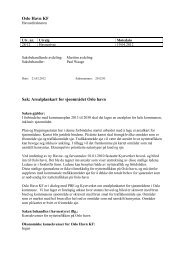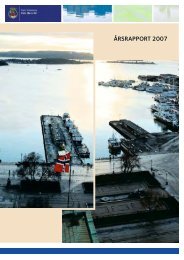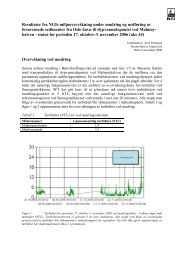Oslo Fjord Clean Up - Ren Oslofjord
Oslo Fjord Clean Up - Ren Oslofjord
Oslo Fjord Clean Up - Ren Oslofjord
- No tags were found...
You also want an ePaper? Increase the reach of your titles
YUMPU automatically turns print PDFs into web optimized ePapers that Google loves.
Background to the projectThe clean-up project is part of an integrated planof remediation measures for marine areas withinthe <strong>Oslo</strong> <strong>Fjord</strong>. The project is also a step in a concertednational effort to remediate contaminatedsediments. The <strong>Oslo</strong> project is timed to supportthe ongoing construction of an immersed tunnel inparts of the port.The study underlying the clean-up of the <strong>Oslo</strong><strong>Fjord</strong>, conducted over a ten year period, is acollaborative effort by professional entities inthe City of <strong>Oslo</strong> administration, the Port of <strong>Oslo</strong>Authority, Norwegian research institutes and others.Analyses have shown unacceptable levels ofenvironmental toxins.Aim of the projectThe aim of remediation of the contaminatedseabed is two-fold:1. to remove contaminated material from theharbour basin, thereby preventing the resuspensionand dispersal of environmental toxinsin the inner <strong>Oslo</strong> <strong>Fjord</strong>.2. to improve navigation depth in the interestsof safe vessel traffic, and to carry out urbanrenewal measures.4
Who is responsible for the clean-upand who is financing the project?While the “polluter pays principle” underlies allenvironmental remediation in Norway, this cannotbe enforced in the <strong>Oslo</strong> <strong>Fjord</strong> since the polluters(manufacturing industries formerly situated alongthe coastline) no longer exist.However, various road and urban developmentprojects in the port area have presented financingopportunities. The clean-up now under way isa cost-sharing collaboration between the City of<strong>Oslo</strong>, the Port of <strong>Oslo</strong> Authority, the NorwegianPublic Roads Administration and developers inthe port area. The Norwegian Pollution ControlAuthority (NPCA) has also made funds available.All in all about NOK 130 million will be spent oncleaning up the port, in addition to remediationof marinas, bathing areas and rivers.Participants in the remediationprocess are:The Port of <strong>Oslo</strong>, tasked with achievinga clean <strong>Oslo</strong> <strong>Fjord</strong>The Norwegian Pollution Control Authority(NPCA), which has set the premises for dredgingoperations and the requirements to be metSecora, by contract with the Port of <strong>Oslo</strong>,responsible for dredging and disposalThe Norwegian Geotechnical Institute, bycontract with the Port of <strong>Oslo</strong>, tasked withmonitoring, dredging and disposal operationsto ensure compliance with NPCA directivesThe remediation project, named “<strong>Oslo</strong> <strong>Fjord</strong> <strong>Clean</strong><strong>Up</strong>”, got under way in 2005.What kinds of substances are involved?The seabed in the port area contains polychlorinatedbiphenyls (PCBs), tri-butyl-tin compounds(TBTs), polyaromatic hydrocarbons(PAHs), mercury (Hg), lead (Pb) and cadmium(Cd). Moreover, large quantities of untreatedsewage and surface water were released fromthe end of the 1800s until purification plantswere installed and upgraded in recent times.Although not acutely toxic, these substancescan be taken up into the food chain and storedin the body’s fatty tissue and liver. Combined withother environmental toxins to which we are exposed,they may be harmful in the longer term. However,the contaminated seabed is not defined as hazardouswaste. Its content of hazardous environmentaltoxins such as PCBs and mercury amounts to a fewparts per thousand. More than 90 per cent consistsof sand, silt and clay, 5-10 per cent organic matter(leaves and dead algae), heavy metals and organicenvironmental toxins.5
What solutions are available?Various solutionsVarious measures are taken to improve thestate of contaminated sediments. There arecurrently two main remediation methods:1.Capping the contaminated sediments with cleanmaterial to form a new, clean seabed above them.2.Removal of the contaminated sedimentsfrom the seabed by dredging andplacing them in an approveddisposal facility.6
Which solution did we choose?Both capping and dredging were selected in the <strong>Oslo</strong> <strong>Fjord</strong> <strong>Clean</strong> <strong>Up</strong>Project. Some of the contaminated sediments will be capped; theremainder will be dredged and stored in a disposal facility.CappingThe contaminated sediments will be capped usingclean clay recovered from the tunnel constructionproject.DredgingThe sediments will be dredged using a speciallydesigned closed grab to minimise resuspension.DisposalThe sediments will be stored in a deep-waterdeposit site located near the head of the <strong>Oslo</strong> <strong>Fjord</strong>.8
Important criteria for selectingdredging equipmentIt should:• cause minimal seabed resuspension• permit accurate dredging resulting in minimalcontaminated volume for disposal• produce pumpable matter for placement into thedisposal facility• have high capacity• do the job quickly• run quietly• incur favourable costs• cause little inconvenience to ship traffic in theperiod of operation• enable removal of metal scrap from the dredgedsediments• permit archaeological monitoring9
DredgingCapping with clean materialsPossible cappping laterDeep sea disposal siteWhat volumes andareas will be cappedand dredged?The contaminated sediments varyin thickness from 0,1 to 4,5 m.Approximately 650.000 m³ of thecontaminated sediments in the shallowparts of the harbour will be dredged.The deeper zones of the harbour, outsidethe dredged areas, will be capped.Map: Statens forurensningstilsyn, 2006Source: Norges Geotekniske Institutt og Statens kartverk10
About the dredgingSecora’s contract with the Port of <strong>Oslo</strong> for thedredging of 500,000 m 3 of contaminatedsediments from the harbour basin in <strong>Oslo</strong>, alongwith transport and placement into the deep-waterdeposit site, has so far proceeded as planned.The dredging vessel uses an excavator fitted witha specially designed grab which loads the materialsdirectly onto a barge. The grab has a speciallydesigned “lid” which closes when the bucket israised to the surface, thereby reducing spillage andresuspension. The operator controls the grab usinginformation fed into a system of maps showing thelevel of the present seabed and the thickness of thelayer to be dredged. Sensors on the dredger combinedwith map presentation enable the operationto be carried out in real time. By this means the systemrecords the progress made in the dredging area.12
Illustrasjon om mudringDredging: Example of mechanical dredging. Diagram: NGIArild W Solerød13
Displacement operated pump.Salt container.About the disposal facilityThere were several reasons for selecting the locationof the deep-water deposit site. The selected basin isat some depth, approaching 70 m, and is encircledby relatively shallow natural barriers that minimisethe risk of dispersal beyond the facility. The seabedin the area was already heavily contaminated havingpreviously been used as a dumping area for wastesuch as clay and ballast and scrapped ships/boats.The transport distance from the dredging area isshort, enabling good logistics. The disposalfacility also has the capacity needed to receive theprojected volume of dredged sediments.The sediments are transported by barge to thedeep-water deposit site and are transported intothe facility by means of a permanently anchoreddredged material placement unit. Two barges areused to achieve optimal work flow.The unit features a displacement operated pump.The pump is lowered into the barge’s hold and thesediments are pumped directly into a transport linewhich extends right down to the seabed with adiffuser (flow dampener) at its base which changesthe direction of the outflow by 90 degrees. Thediameter of the transport line increases withincreasing depth and this, together with the diffusor,slows the material’s outflow velocity into theseabed and reduces the likelihood of particledispersion to the water column.In order to maintain high water density at increasingdepths, salt is added to ensure that the excesswater accompanying the dredged material achieves adensity equal to or higher than the bottom water inthe disposal facility. Between 800 and 1500 kg ofsalt are added to each barge load, depending on thequantity and salinity of the excess water.14
Placement technique for dredging material in deep-water deposit siteBefore disposalDuring disposalAfter disposalSource: Ministry of the Environment16
Monitoring and control of thedisposal facilityArild W SolerødThe Norwegian Geotechnical Institute is responsible for the extensivecontrol and monitoring programme around the disposal facility and thedredging operations. The measurements are carried out as follows:On-line control of turbidity and near-bottomcurrent velocities. Measuring sensors aresuspended three metres above the seabed as wellas at different depths and transmit readingsdirectly to the NGI by SMS.Regular and systematic sampling and analysis ofthe water to ascertain the quantity of heavymetals, PCBs, PAHs and TBTs.Periodic sampling and analysis of sedimentdeposited in sediment traps outside thedisposal site.Measurement of dissolved PCBs and PAHs atdifferent depths using passive samplers to achievea time-integrated sampling.Visual checks by Remotely Operated Vehicle (ROV)Monitoring buoys have been deployed to measureturbidity in the water around the deep-water depositsite. In addition, background turbidity measurementsare monitored from a reference buoy further to thenorth in the Bekkelag Basin.17
End resultThe dispersal of PCBs and PAHsfrom the dredging of the contaminatedseabed in the Port of <strong>Oslo</strong> isdivided into three phases:Dispersal of PCBs and PAHs duringdisposal of contaminated seabedsediments at Malmøykalven is alsodivided into three phases:Dispersal prior to project implementationEstimated (based on measured values) at 232 gramsof PCBs per year and 5.7 kilos of PAHs per year.Relevant mechanisms assessed are diffusion andresuspension of particles/propeller erosion.Dispersal during dredging operationsEstimated at a total of 388 grams of PCBs and 13.9kilos of PAHs during the remediation period. Theraised levels are due to particle resuspension. Thereis additional diffusion from the sediments in thedredging areas and resuspension/propeller erosion.Since the bulk of the contamination is boundto particles, the Norwegian Pollution ControlAuthority has focused on monitoring and controlof turbidity in this phase.Dispersal after project completionThe Norwegian Pollution Control Authorityrequires the seabed to match condition level IIafter dredging, which is a stringent requirement inurban areas. Dispersal after project completion isestimated at 12 grams of PCBs and 228 grams ofPAHs per year. Dispersal is by diffusion and resuspensionof particles from dredged areas.Dispersal from the disposal facility areaprior to project implementationThe seabed in the disposal facility area is contaminatedat present. Dispersal from the area is estimatedat 5.2 grams of PCBs and 822 grams of PAHs peryear. Since current velocities are low, dispersal is bydiffusion alone.Dispersal during disposalEstimated at a total of 160 grams of PCBs and4.1 kilos of PAHs during the remediation period.Dispersal is via excess water, particle resuspension,diffusion and expulsion of pore water.Dispersal after cappingEstimated at 0.5 grams of PCBs and 1.6 grams ofPAHs per year. Only dispersal by diffusion throughthe cap is considered relevant. Also measured at theSolbergstrand research station.Major environmental benefits fromremediating the seabedCalculations show major environmental benefitsfrom dredging contaminated seabed sedimentsin the Port of <strong>Oslo</strong> and disposing of them atMalmøykalven. The dredged material in the deepwaterdeposit site will be capped with clean material.The seabed in parts of the Port of <strong>Oslo</strong> willalso be capped with clean material, bringing aneven larger environmental benefit as a result of theclean-up.18
Seabed before and after dredging and cappingSource: Ministry of the Environment20
FAQsWhy is the dredged material not storedashore?Disposal ashore has drawbacks, for example extensivetransport and disposal area requirements andrisks for future run-off. The solution to move thematerial to a deep water disposal facility is consideredto be safe and the overall best solution forclean up of the <strong>Oslo</strong> <strong>Fjord</strong> area.Why won’t pollutants leak from thefacility?The deep water deep-water deposit site will beestablished in a natural depression in the seabed,60-70 metres below the sea surface. After the contaminatedmaterial is capped, dispersal of pollutantswill be greatly reduced. Moreover, the cap isthick enough to ensure the safety of marine animalsinhabiting the sediments.Why not leave the contaminatedmaterial where it is?This is not an option since environmental toxinswill constantly be stirred up from the sea bed dueto port activities and activities in shallow marinas.What is being done to check that thedeposited material will remainstationary after the job has been done?Once the disposal has reached completion the facilityand the cap will be regularly monitored. ThePort of <strong>Oslo</strong> is required to demonstrate that nopollution is transported through the cap, and tosurvey animal life on the seabed. The NorwegianPollution Control Authority will determine whenmonitoring can be scaled back.21
GlossaryDiffusorA device at the end of the transport line which reduces the speed of thematerial and distributes the dredged material over the seabed.DredgingAn excavation activity or operation usually carried out at least partlyunderwater, in shallow seas or fresh water areas for the purpose of collectingbottom sediments and disposing of them at a different location.Environmental toxinsSubstances likely to damage the ecosystem even at low concentrations.ResuspensionSedimentsTurbidityStirring up of particles in the water column to form a mix of solids andwaterSeabed sludge, depositsExpression of water’s clarity or concentration of particles in the water22
Referenceswww.sft.nowww.renoslofjord.nowww.miljostatus.noKonsekvensutredning for dypvannsdeponi,<strong>Oslo</strong> havnevesen 2001Helhetlig tiltaksplan for forurensedesedimenter i <strong>Oslo</strong> havnedistrikt 2005Årsrapport 2006 Overvåking av forurensingved mudring og deponering, NGINGI 2007, Arne Pettersen et al. ConfinedAquatic Disposal Facility in a Deep <strong>Fjord</strong>Basin: The <strong>Oslo</strong> Harbour RemediationProject.23
LINE NYBORG DESIGN ASLine Nyborg Design AS. Foto side 19: Sissel Flo Nilsen. 2007. Opplag: 2000LINE NYBORG DESIGN AS<strong>Oslo</strong> Havn KF, postboks 230 Sentrum, 0103 <strong>Oslo</strong>Telefon: 02 180, Faks: 23 49 26 01E-post:postmottak@havnevesenet.oslo.kommune.nowww.ohv.oslo.nowww.renoslofjord.no24





